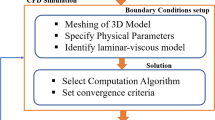Abstract
Porous structures have shown promise in biomedical applications, particularly for artificial implants, because they provide a large surface area for bone ingrowth. A simulation analysis model was developed in this study to evaluate the mechanical properties of various designs based on cubic unit cell scaffolds with varying strut geometries at the same porosity. Based on the diameter and cross-section type of the struts, porous bone scaffolds with the same porosity were developed. The porous structure bone scaffold with square cross-section struts is larger based on the pore size measurements. The porous structure bone scaffold with square cross-section struts has the highest compressive strength and modulus elasticity, according to this study. All bone scaffolds with porous structures, however, may meet the trabecular bone criteria (pore size, porosity, interconnectivity, and biocompatibility), but not the cortical bone criteria. Biomaterials with higher mechanical properties, or polymers combined with ceramics, will need to be researched in the future to match cortical bone's mechanical strength.
Access this chapter
Tax calculation will be finalised at checkout
Purchases are for personal use only
Similar content being viewed by others
References
Kim TB, Yue S, Zhang Z, Jones E, Jones JR, Lee PD (2014) Additive manufactured porous titanium structures: through-process quantification of pore and strut networks. J Mater Process Technol 214(11):2706–2715. https://doi.org/10.1016/j.jmatprotec.2014.05.006
Arabnejad S, Burnett Johnston R, Pura JA, Singh B, Tanzer M, Pasini D (2016) High-strength porous biomaterials for bone replacement: a strategy to assess the interplay between cell morphology, mechanical properties, bone ingrowth and manufacturing constraints. Acta Biomater 30:345–356. https://doi.org/10.1016/j.actbio.2015.10.048.
Kienapfel H, Sprey C, Wilke A, Griss P (1999) Implant fixation by bone ingrowth. J Arthroplasty 14(3):355–368. https://doi.org/10.1016/S0883-5403(99)90063-3
Van Bael S et al (2012) The effect of pore geometry on the in vitro biological behavior of human periosteum-derived cells seeded on selective laser-melted Ti6Al4V bone scaffolds. Acta Biomater 8(7):2824–2834. https://doi.org/10.1016/j.actbio.2012.04.001
Mullen L, Stamp RC, Brooks WK, Jones E, Sutcliffe CJ (2009) Selective laser melting: a regular unit cell approach for the manufacture of porous, titanium, bone in-growth constructs, suitable for orthopedic applications. J Biomed Mater Res Part B Appl Biomater 89(2):325–334. https://doi.org/10.1002/jbm.b.31219
Lasprilla AJR, Martinez GAR, Lunelli BH, Jardini AL, Filho RM (2012) Poly-lactic acid synthesis for application in biomedical devices—a review. Biotechnol Adv 30(1):321–328. https://doi.org/10.1016/j.biotechadv.2011.06.019
Tyler B, Gullotti D, Mangraviti A, Utsuki T, Brem H (2016) Polylactic acid (PLA) controlled delivery carriers for biomedical applications. Adv Drug Deliv Rev 107:163–175. https://doi.org/10.1016/j.addr.2016.06.018
Gupta B, Revagade N, Hilborn J (2007) Poly(lactic acid) fiber: an overview. Prog Polym Sci 32(4):455–482. https://doi.org/10.1016/j.progpolymsci.2007.01.005
Alizadeh-Osgouei M, Li Y, Vahid A, Ataee A, Wen C (2021) High strength porous PLA gyroid scaffolds manufactured via fused deposition modeling for tissue-engineering applications. Smart Mater Med 2:15–25. https://doi.org/10.1016/j.smaim.2020.10.003
Amin Yavari S et al (2015) Relationship between unit cell type and porosity and the fatigue behavior of selective laser melted meta-biomaterials. J Mech Behav Biomed Mater 43:91–100. https://doi.org/10.1016/j.jmbbm.2014.12.015
Sohrabian M, Vaseghi M, Khaleghi H, Dehrooyeh S, Kohan MSA (2021) Structural investigation of delicate-geometry fused deposition modeling additive manufacturing scaffolds: experiment and analytics. J Mater Eng Perform 30(9):6529–6541. https://doi.org/10.1007/s11665-021-05894-y
Olivares AL, Marsal È, Planell JA, Lacroix D (2009) Finite element study of scaffold architecture design and culture conditions for tissue engineering. Biomaterials 30(30):6142–6149. https://doi.org/10.1016/j.biomaterials.2009.07.041
Shi C, Lu N, Qin Y, Liu M, Li H, Li H (2021) Study on mechanical properties and permeability of elliptical porous scaffold based on the SLM manufactured medical Ti6Al4V. PLoS One 16(3):1–17. https://doi.org/10.1371/journal.pone.0247764
Wieding J, Wolf A, Bader R (2014) Numerical optimization of open-porous bone scaffold structures to match the elastic properties of human cortical bone. J Mech Behav Biomed Mater 37:56–68. https://doi.org/10.1016/j.jmbbm.2014.05.002
Farah S, Anderson DG, Langer R (2016) Physical and mechanical properties of PLA, and their functions in widespread applications—a comprehensive review. Adv Drug Deliv Rev 107:367–392. https://doi.org/10.1016/j.addr.2016.06.012
Zaharin et al (2018) Effect of unit cell type and pore size on porosity and mechanical behavior of additively manufactured Ti6Al4V scaffolds. Materials (Basel) 11(12). https://doi.org/10.3390/ma11122402
Srinivasan H, Tsoutsanis P (2016) Adaptive mesh refinement techniques for high-order finite-volume weno schemes. ECCOMAS Congr 2016 Proc 7th Eur Congr Comput Methods Appl Sci Eng 2:2883–2899. https://doi.org/10.7712/100016.2003.8544
Vakrčka P, Jíra A, Hájková P (2020) Mechanical testing and numerical modelling of porous structures improving oseintegration of implants. Acta Polytech CTU Proc 26:127–133. https://doi.org/10.14311/APP.2020.26.0126
Bagde AD et al (2019) Geometric modeling and finite element simulation for architecture design of 3d printed bio-ceramic scaffold used in bone tissue engineering. J Indian Inst Sci 99(3):361–374. https://doi.org/10.1007/s41745-019-00120-0
Khodaei M, Amini K, Valanezhad A (2020) Fabrication and characterization of poly lactic acid scaffolds by fused deposition modeling for bone tissue engineering. J Wuhan Univ Technol Mater Sci Ed 35(1):248–251. https://doi.org/10.1007/s11595-020-2250-4
Cho YS, Gwak SJ, Cho YS (2021) Fabrication of polycaprolactone/nano hydroxyapatite (Pcl/nha) 3d scaffold with enhanced in vitro cell response via design for additive manufacturing (dfam). Polymers (Basel) 13(9). https://doi.org/10.3390/polym13091394
Tang MS, Abdul Kadir AZ, Ngadiman NHA (2020) Simulation analysis of different bone scaffold porous structures for fused deposition modelling fabrication process. In: 5th International Conference on Mechanical Engineering Research 2019, ICMER 2019, vol 788. https://doi.org/10.1088/1757-899X/788/1/012023
Li Y, Yang C, Zhao H, Qu S, Li X, Li Y (2014) New developments of ti-based alloys for biomedical applications. Materials 7(3):1709–1800. https://doi.org/10.3390/ma7031709
Acknowledgements
The authors are grateful to the Deputy for Strengthening Research and Development, the Ministry of Research and Technology and Higher Education, Republic of Indonesia, for research funding under Doctoral Research Grants Number: 345-35/UN7.6.1/PP/2022.
Author information
Authors and Affiliations
Corresponding author
Editor information
Editors and Affiliations
Rights and permissions
Copyright information
© 2024 The Author(s), under exclusive license to Springer Nature Singapore Pte Ltd.
About this paper
Cite this paper
Winarso, R., Ismail, R., Anggoro, P.W., Jamari, J., Bayuseno, A.P. (2024). Porous Structures Simulation Analysis: The Effect of Different Strut Geometry on the Bone Scaffold. In: Irwansyah, Iqbal, M., Huzni, S., Akhyar (eds) Proceedings of the 4th International Conference on Experimental and Computational Mechanics in Engineering. ICECME 2022. Lecture Notes in Mechanical Engineering. Springer, Singapore. https://doi.org/10.1007/978-981-99-7495-5_11
Download citation
DOI: https://doi.org/10.1007/978-981-99-7495-5_11
Published:
Publisher Name: Springer, Singapore
Print ISBN: 978-981-99-7494-8
Online ISBN: 978-981-99-7495-5
eBook Packages: EngineeringEngineering (R0)




